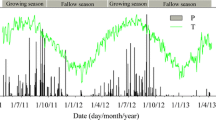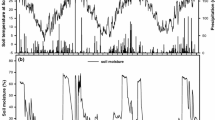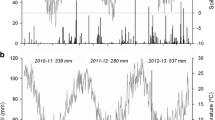Abstract
Methane emissions from a flooded Louisiana, USA, rice field were measured over the first cropgrowing season. Microplots contained the semidwarf Lemont rice cultivar drill seeded into a Crowley silt loam soil (Typic Albaqualfs). Urea fertilizer was applied preflood at rates of 0, 100, 200 and 300 kg N ha−1. Emissions of CH4 from the plots to the atmosphere were measured over a 86-d sampling period until harvest. Methane samples were collected in the morning hours (07∶30–09∶30) using a closed-chamber technique. Emissions of CH4 were highly variable over the first cropping season and a significant urea fertilizer effect was observed. Two peak CH4 emission periods were observed and occurred about 11 d after panicle differentiation and during the ripening stages. Maximum CH4 emmissions from the 0, 100, 200 and 300 urea-N treatments were 6.0, 8.9, 9.8 and 11.2 kg CH4 ha−1 d−1, respectively. These flux measurements corresponded to approximately 210, 300, 310 and 360 kg CH4 evolved ha−1 over the 86-d sampling period for the 4 treatments.
Similar content being viewed by others
References
Aselmann I and Crutzen P J 1989 Freshwater Wetlands: Global distribution of natural wetlands and rice paddies: Their net primary productivity, seasonality and possible methane emissions. J. Atmt. Chem. (In press).
Blake D R and Rowland F S 1988 Continuing worldwide increase in tropospheric methane, 1978 to 1987. Science 239, 1129–1131.
Bolle H J, Seiler W and Brolin B 1986 Other greenhouse gases and aerosols. Assessing their role in atmospheric radiative transfer.In The Greenhouse Effect, Climate Change and Ecosystems. Ed. B, Bolin. Scope, Vol. 29. Wiley, New York.
Cicerone R J and Shetter J D 1981 Sources of atmospheric methane: Measurements in rice paddies and a discussion. J. Geophys. Res. 86, 7203–7209.
Cicerone R J and Shetter J D and Delwiche C C 1983 Seasonal variations of methane flux from a California rice paddy. J. Geophy. Res. 88, 11022–11024.
De Datta S K 1981 Principles and Practices of Rice Production. Wiley, New York. 618 p.
Food and Agriculture Organization of the United Nations 1985 Fertilizer Yearbook, Vol. 35. FAO Statistical Series No. 71, FAO, Rome.
Holzapfel-Pschorn A, Conrad R and Seiler W 1985 Production, oxidation and emission of methane in rice paddies. FEMS Microbiol. Ecol. 31, 343–351.
Holzapfel-Pschorn A, Conrad R and Seiler W 1986 Effects of vegetation on the emission of methane from submerged paddy soils. Plant and Soil 92, 223–233.
Holzapfel-Pschron A and Seiler W 1986 Methane emission during a cultivation period from an Italian rice paddy. J. Geophys. Res. 91, 11803–11814.
National Aeronautics and Space Administration 1988 Earth System Science, A Closer View. NASA, Washington, D.C.
Patrick W H Jr and DeLaune R D 1977 Chemical and biological redox systems affecting nutrient availability in coastal wetlands. Geosci. Man. 18, 131–137.
Patrick W H Jr 1981 The role of inorganic redox systems in controlling reduction in paddy soils.In Proceedings of Symposium on Paddy Soils. Ed. Institute of Soil Science Academia Sinica. pp 107–117. Science Press, Beijing, China.
Reddy K R and Patrick W H Jr 1984 Nitrogen, transformations and loss in flooded soils and sediments.In CRC Critical Reviews in Environmental Control. pp 274–309. CRC Press, Boca Raton, FL.
Rolston DE 1986 Gas Flux.In Methods of Soil Analysis, Part 1: Physical and Mineralogical Methods. Ed. A. Klute. pp 1103–1119. ASA, Madison, WI.
Rowland F S 1989 Chlorofluorocarbons an, the depletion of stratospheric ozone. Am. Sci. 77, 36–45.
Schutz H, Holzapfel-Pschorn A, Conrad R, Rennenberg H and Seiler W 1989a A 3-year continuous record on the influence of daytime, season, and fertilizer treatment on methane emission rates from an Italian rice paddy. J. Geophy. Res. 94, 16405–16416.
Schutz H, Seiler W and Conrad R 1989b Processes involved in formation and emission of methane in rice paddies. Biogeochemistry 7, 33–53.
Seiler W, Holzapfel-Pschorn A, Conrad R and Scharffe D 1984 Methane emission from rice paddies. J. Atm. Chem. 1, 241–268.
Statistical Analysis System 1988 SAS/STAT User's Guide, Release 6.03 Edition. SAS Institute Inc., Cary, NC. 1028 p.
United States Department of Agriculture/Environmental Protection Agency 1989 Workshop on Greenhouse Gas Emissions from Agricultural Systems IPCC-RSWG, 12–14 December, 1989. USEPA, Washington, DC.
Yagi K and Minami K 1989 Effects of organic matter applications on methane emission from Japanese paddy fields.In Soils and the Greenhouse Effect. Ed. A F Bouwman. pp 016-1–016-5. Int. Soil Reference Information Centre (ISRIC) Wageningen, The Netherlands.
Author information
Authors and Affiliations
Rights and permissions
About this article
Cite this article
Lindau, C.W., Bollich, P.K., Delaune, R.D. et al. Effect of urea fertilizer and environmental factors on CH4 emissions from a Louisiana, USA rice field. Plant Soil 136, 195–203 (1991). https://doi.org/10.1007/BF02150050
Received:
Revised:
Issue Date:
DOI: https://doi.org/10.1007/BF02150050




